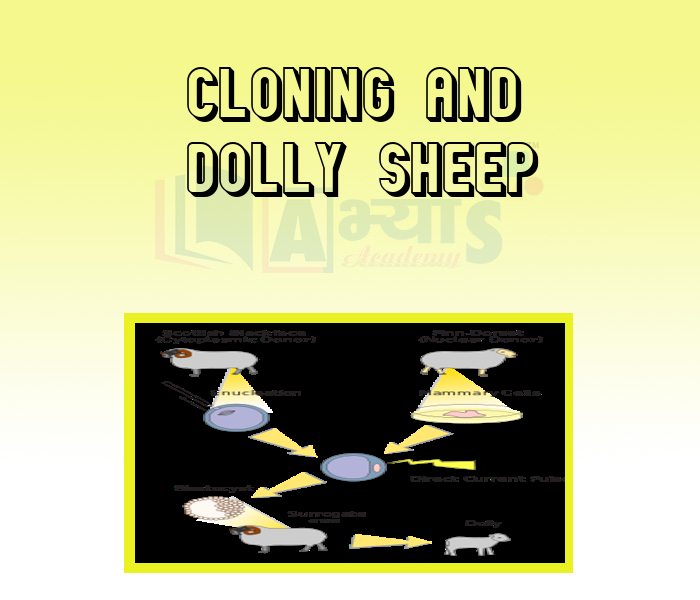Cloning And Dolly Sheep







Cloning And Dolly Sheep
Cloning is the production of an exact copy of an animal by means of asexual reproduction. Any two animals which contain exactly the same genes are called 'genetically identical'. An animal which is genetically identical to its parent is called a clone. A clone is an exact copy of its parent.
The cloning of animals is a special kind of asexual reproduction method. The cloning in animals is done by the transfer of 'nucleus' of a cell. This happens as follows:
Before we describe the cloning of Dolly sheep in detail, we should know the meaning of the term 'ewe'. Ewe is a female sheep. The two sheep which were involved in the cloning of Dolly sheep were Finn Dorset ewe and Scottish Blackface ewe. We can also call them female Finn Dorset sheep and female Scottish Blackface sheep. As the name suggests, the Scottish Blackface sheep has a black face. Keeping these points in mind, we will now describe the cloning of 'Dolly' sheep from Finn Dorset ewe.
Cloning of 'Dolly' Sheep:
The Dolly sheep was cloned in the following way:
Dolly was a clone of Finn Dorset sheep and produced several offsprings of her own through sexual means in due course of time. Dolly had exactly the same genetic material as her real mother Finn Dorset sheep. Dolly died on 14th February 2003 due to a lung disease.
Since Dolly, the cloned sheep. who was born in 1996, cows (and pigs) have been cloned. The cloning of superior cows which give high milk yield has become possible now. If a high milk yielding cow was to be mated with a bull for reproduction, then the resulting offspring cow may or may not be of high milk yielding breed (because of intermixing of genes of the parent bull and mother cow). On the other hand, a cow which is cloned from a parent cow of high milk yield will be an identical copy of the parent cow and hence give high milk yield.
Advantages of Cloning
The technique of cloning enables us to produce exactly identical copies of domestic animals having favourable characteristics (without the risk of losing some of the béneficial genes or introducing unwanted genes through sexual reproduction methods). Cloning produces identical copies of the parent domestic animals and helps in preserving desirable features (like high milk yield or good quality wool) of the parent animal for future generations. For example :

The technique of cloning enables us to produce exactly ___________________ copies of domestic animals having favourable characteristics . | |||
| Right Option : B | |||
| View Explanation | |||
A sheep which gives high yield of superior quality wool can be cloned to produce exactly ____________________ sheep which will give high yield of superior quality wool. | |||
| Right Option : A | |||
| View Explanation | |||
Which of the following are correct : (a) Dolly (the cloned sheep) was born on 5th July, 1996. (b) Dolly sheep was the first mammal to be cloned.
| |||
| Right Option : C | |||
| View Explanation | |||
Students / Parents Reviews [10]
It was a good experience with Abhyas Academy. I even faced problems in starting but slowly and steadily overcomed. Especially reasoning classes helped me a lot.

Cheshta
10thA marvelous experience with Abhyas. I am glad to share that my ward has achieved more than enough at the Ambala ABHYAS centre. Years have passed on and more and more he has gained. May the centre flourish and develop day by day by the grace of God.

Archit Segal
7thOne of the best institutes to develope a child interest in studies.Provides SST and English knowledge also unlike other institutes. Teachers are co operative and friendly online tests andPPT develope practical knowledge also.

Aman Kumar Shrivastava
10thAbout Abhyas metholodology the teachers are very nice and hardworking toward students.The Centre Head Mrs Anu Sethi is also a brilliant teacher.Abhyas has taught me how to overcome problems and has always taken my doubts and suppoeted me.

Shreya Shrivastava
8thMy experience with Abhyas is very good. I have learnt many things here like vedic maths and reasoning also. Teachers here first take our doubts and then there are assignments to verify our weak points.

Shivam Rana
7thBeing a parent, I saw my daughter improvement in her studies by seeing a good result in all day to day compititive exam TMO, NSO, IEO etc and as well as studies. I have got a fruitful result from my daughter.

Prisha Gupta
8thMy experience was very good with Abhyas academy. I am studying here from 6th class and I am satisfied by its results in my life. I improved a lot here ahead of school syllabus.

Ayan Ghosh
8thMy experience with Abhyas academy is very good. I did not think that my every subject coming here will be so strong. The main thing is that the online tests had made me learn here more things.

Hiya Gupta
8thI have spent a wonderful time in Abhyas academy. It has made my reasoning more apt, English more stronger and Maths an interesting subject for me. It has given me a habbit of self studying

Yatharthi Sharma
10thIt was good as the experience because as we had come here we had been improved in a such envirnment created here.Extra is taught which is beneficial for future.
